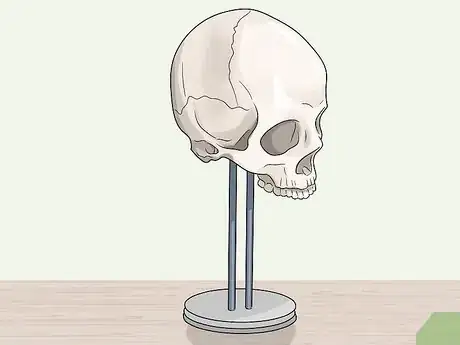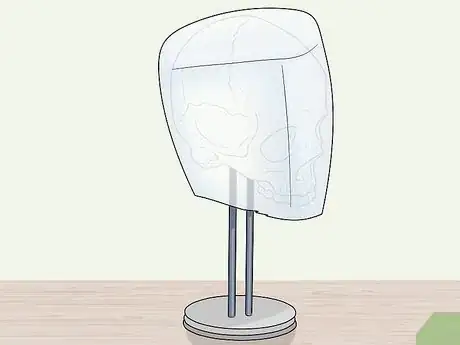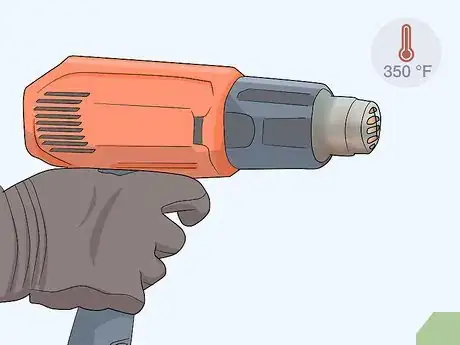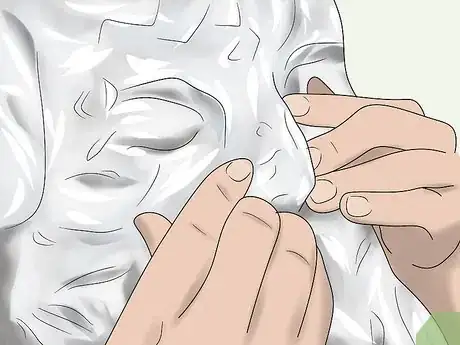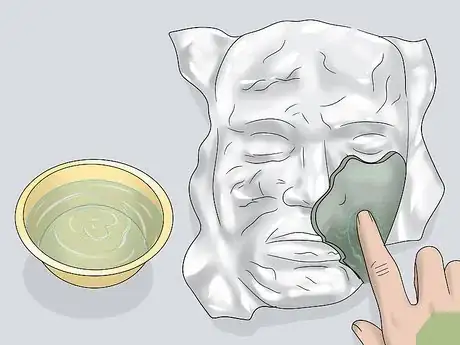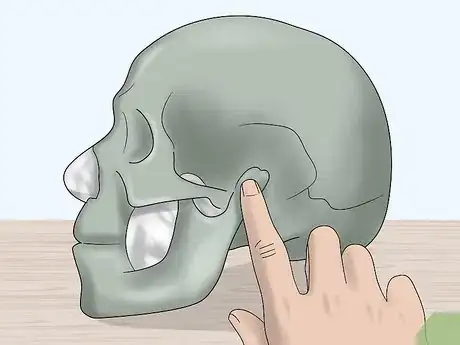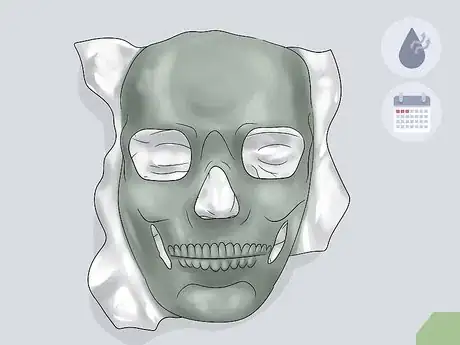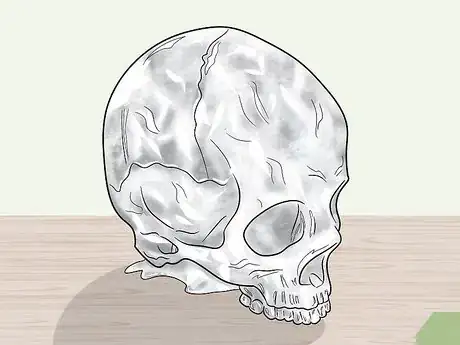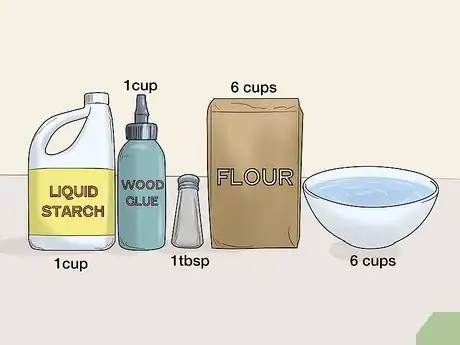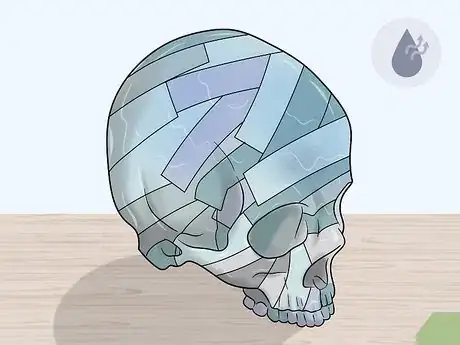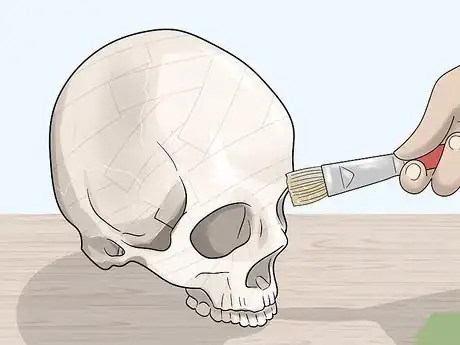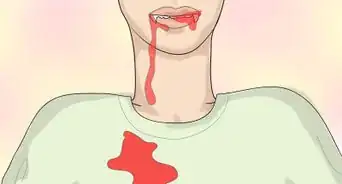This article was co-authored by wikiHow Staff. Our trained team of editors and researchers validate articles for accuracy and comprehensiveness. wikiHow's Content Management Team carefully monitors the work from our editorial staff to ensure that each article is backed by trusted research and meets our high quality standards.
There are 11 references cited in this article, which can be found at the bottom of the page.
This article has been viewed 23,605 times.
Learn more...
Whether you're getting ready for a Halloween party or simply want a spooky decoration to display all year round, faux human skulls are a cool yet creepy craft you can make at home. Form one out of an old milk jug if you want to recycle your plastic or shape a skull out of modeling clay or paper mâché for a more artsy endeavor. Either way, you'll die over how awesome your skull turns out (pun intended!).
Steps
Using a Milk Jug to Make a Skull
-
1Cut the handle and top off a 1 gallon (3.8 L) milk jug. Use an X-Acto knife to carefully cut around the open top of the jug along with the handle on the back in one piece. This leaves an opening large enough to slip the jug over the skull later on.[1]
- You don’t need to cut away more than about 1 inch (2.5 cm) around the top and handle.
- It may help to trace the outline of the area you’re going to cut with a marker first to help guide the knife.
-
2Set the resin skull, which is your mold, onto a metal paper towel holder. Place the bottom of the skull on top of the dowel so the skull is rightside up. This creates a temporary stand for the skull.[2]
- If your skull doesn’t have an opening at the base, use an X-Acto knife or box cutter to cut a hole that your dowel can fit inside.
- You can buy resin skulls at a party store, Halloween store, or online retailer.
Tip: Make your own stand for the skull by gluing a section of PVC piping that's about 12 inches (30 cm) long onto a 8 to 12 in (20 to 30 cm) piece of wood using wood glue.
Advertisement -
3Slip the jug over the skull so that the front of the jug is over the face. Put the opening that you cut in the milk jug over top of the resin skull and press the jug down so it covers the skull. Make sure the front of the jug lines up with the front of the skull, where the eyes and mouth are.[3]
- If you’re having difficulty fitting the skull into the opening on the jug, cut a small slit up the back of the jug to help open it up a little further.
-
4Put on heat gloves and then turn the heat gun up to a high setting. Plug the gun into an electrical outlet and set the gun to at least 350 °F (177 °C) to help warm the plastic faster. Always wear heat gloves when you’re using a heat gun so your hands are protected and don’t get burned.[4]
- You can buy a heat gun from a hardware store or an online retailer.
- Never touch the nozzle of a heat gun when it’s turned on as it’s incredibly hot.
-
5Hold the gun 3 in (7.6 cm) away as you move it over the jug to heat it. Use small circular motions as you slowly move the heat gun over the entire jug until the plastic is clear instead of translucent. This allows the plastic to be formed into different shapes.[5]
- Don’t hold the heat gun in one spot for more than 3 to 5 seconds or hold it too close to the jug. Otherwise, you’ll melt the plastic.
-
6Use a sponge dipped in cold water to press the hot plastic around the skull. While the plastic is still warm from the gun, wet a sponge with cold water and wipe it over the jug, starting with the cheekbones and face before moving to the top of the skull. Press firmly as you wipe so that the plastic molds to the shape of the skull beneath it.[6]
- Work quickly as the plastic isn't moldable once it cools. You can always reheat sections as you go if they cool off before you shape them.
- Wring out the sponge as you go so that it's damp but not dripping. You'll need to re-dip the sponge as you work.
- Tuck the extra plastic at the bottom of the jug up around the skull to form the jawline.
Tip: To get more detail on the teeth, use a small screwdriver to press in between each tooth.
-
7Run the jug under cold water for 2 minutes before pulling it off the skull. To cool the plastic and set your skull shape, tilt the dowel sideways so the skull is underneath the faucet in the sink and hold the plastic under cold water for at least 2 minutes. Then, pop it off the resin skull the same way you put it on.
- If you can’t remove the jug through the opening, cut an additional slit on the back of the jug so you can maneuver it off the skull. Glue the slit back together once the jug is removed.
-
8Apply 2 to 3 coats of acrylic paint if you want your skull to be a certain color. To make your skull any color besides clear plastic, use a paintbrush to coat the jug in 2 to 3 layers of acrylic paint in the shade of your choice. Let each coat dry about 30 minutes in between, then let the final coat dry for at least 24 hours.
- Brush on multiple thin coats instead of one thick coat. This prevents the paint from chipping easily or not drying smoothly.
Creating a Clay Skull
-
1Wad up 32.5 ft (9.9 m) of aluminum foil into the shape and size of a human head. Take the aluminum foil and bunch it together tightly. Shape it until you have an oblong sphere that resembles a human head.
Tip: If you struggle with getting the proper dimensions, print out an image of a life-sized human skull that you can use as reference.
-
2Cut your block of clay into pieces that are about 3⁄4 inch (1.9 cm) thick. It doesn’t need to be an exact measurement, but thinner sections of clay are easier to mold. Use scissors to cut up the 1.1 lb (0.50 kg) block of air-hardening modeling clay.
- You can buy modeling clay from a craft store or an online retailer.
-
3Cover the aluminum foil shape by laying the pieces of clay on top of it. Arrange each 3⁄4 in (1.9 cm) thick slab of clay onto the aluminum foil ball so that the pieces lie next to each other. Gently press the edges of each piece together and continue placing them around the foil until the entire base is completely covered.[7]
- Press down firmly as you put the pieces on to make sure they cling tightly to the foil underneath.
- Try to keep the layer of clay even around the entire skull.
-
4Smooth out the clay by rubbing it lightly with water. Dip your hands in water and then run your palms all over the clay-covered shape to smooth out any clumps or wrinkles. Focus more on the top of the skull and any areas that are especially bumpy or uneven.[8]
- Don’t apply the water directly to the clay. Put it on your hands first to avoid over-saturating the clay, which would make it messy and runny.
-
5Wet your thumbs and use them to shape the clay to create the face. Using water on your hands to make the clay easier to mold, create indentations for the eye sockets and in the hollows of the cheeks by pushing in with your thumbs. Then pinch the clay in the center to create the bridge of the nose. Continue shaping with your hands until you’re pleased with the facial structure.[9]
- If you mess up, simply push or pull the clay back to its original shape and try again!
- Keep wetting your hands as you go to help form the clay.
-
6Create 2 small pieces for the jaw and blend them onto each side of the skull. Form 2 pieces for the joints that go on either side of the skull. Make them about .33 inches (0.84 cm) thick so they'll lie flat. Wet the back of the pieces and then press them gently onto the skull, one on the left side and one on the right side, to create the jaw.[10]
- If you're having trouble visualizing what the pieces should look like, search for a template online to use as guidance. You can also print out a template and mold the clay on top of it to help get the ride shape.
-
7Use a modeling tool to draw a mouth and teeth on the jaw. Take a pointy modeling tool and first trace a horizontal line onto the jaw of your skull to represent the mouth. Then carve smaller vertical lines across the horizontal line to create individual teeth. Apply enough pressure that you create an indentation but not so much that you cut through to the foil underneath.
- If you don't have a modeling tool, you can use any sharp object, like a pencil or screwdriver.
Did you know?
An adult human has 32 teeth. If you want to make your skull realistic, draw 16 vertical lines to create an accurate number of teeth.
-
8Add any finishing details and then let the clay dry for at least 72 hours. If you want to carve out a hole in the nasal cavity, for instance, or add suture lines to the top of the skull, do so now with your modeling tool. Otherwise, let the skull dry for at least 3 days before you move it.
- Check the package of your air-hardening modeling clay to find the exact dry time for that specific brand and type.
- Some clay will be dry to the touch in only 24 hours, but it’s safe to wait the entire 72 hours to make sure it’s fully dry all the way through.
Making a Skull out of Paper Mâché
-
1Cover a resin skull with aluminum foil. Lay 2 to 3 sheets of foil over the resin skull, which is serving as your mold. Press the aluminum foil down against the skull so it’s tightly wrapped around it and make sure there are no areas of the original skull left uncovered.[11]
- You can also use plastic wrap instead of aluminum foil.
- Set up your skull over newspaper or another easy-to-clean surface since this project will get messy.
-
2Combine flour, liquid starch, wood glue, water, and salt in a mixing bowl. Add 6 cups (768 g) of flour, 1 cup (240 ml) of liquid starch, 1 cup (240 ml) of wood glue, 6 cups (1,400 ml) of water, and 1 tbsp (17 g) of salt to the bowl. Use a wooden stirring stick to mix it all together until the liquid is a thick, smooth consistency similar to pancake batter.[12]
- If you don’t have a wooden stirring stick, you can use a large spoon or even an electric mixer instead.
Tip: Mix in 1 tablespoon (15 ml) of an odor eliminator or liquid air freshener if you want your paper mâché to smell better.
-
3Rip sheets of newspaper into 2 in (5.1 cm) strips. Take a stack of old newspapers and tear the paper into long strips. Make them all as close to the same width as possible.[13]
- It’s easiest to tear the paper vertically down the sheet instead of horizontally.
- You can also use scissors to cut the paper instead of ripping it.
-
4Dip the strips of newspaper into the liquid mixture to coat them. Dunk each strip into the mixing bowl with the liquid and swish the paper around so that that entire piece is saturated. Pull it out of the liquid and check that there are no dry spots on the newspaper.[14]
- Run your fingers down each strip after you dip it to wipe off any excess liquid.
-
5Place the strips onto the skull until it’s completely covered. Lay each strip onto the skull, pressing down so that the liquid adheres the paper to the skull. Continue overlapping the strips all over the skull until none of the mold is visible. Make sure you smooth down the strips so they lie flush against the skull, forming the right shape.[15]
Tip: Use the end of a small paintbrush to press the paper mâché into any small crevices on the skull, like the nasal cavity or teeth.
-
6Let the paper mâché dry for at least 24 hours. Once you’ve covered the skull in paper mâché, leave it to sit overnight or for at least 24 hours until the newspaper strips are completely dry to the touch. Place the paper mâché skull in an area that’s warm and dry to help it dry quicker.
- If you want the paper mâché to dry even faster, place a fan by the skull so the air blows on it.
-
7Cut a slit down the back of the paper mâché skull to slide it off the resin mold. Use an X-Acto knife to cut a vertical line down the length of the skull in the back. Pop the skull off the mold gently.
- You can also use a box cutter or pocket knife to cut the skull.
- If your skull is stuck to the mold, give it a slight wiggle to loosen it. If you notice the inside layers are still wet, however, leave it to dry longer before trying to remove it again.
-
8Glue the slit together with hot glue and let it dry for 1 to 2 hours. Apply a bead of hot glue along one inside edge of the slit. Press the 2 sides together and hold it for 30 to 60 seconds until the glue hardens. Then leave it to cure for 1 to 2 hours before moving or decorating your skull.
Did you know?
If you want to hide the cut that you made, lay a few newspaper strips dipped in the paper mâché mixture over it once you glue it. Let them dry for 24 hours.
-
9Paint the skull in the color of your choice with acrylic paint. After the slit has dried, use a paintbrush to apply 2 to 3 coats of acrylic paint all over the skull. Let each coat dry at least 30 minutes before applying the next one. After you paint on the final coat, let it sit for about 24 hours, until it's completely dry to the touch.
- Check the package of your paint to find the exact dry time for that specific type or brand.
Things You’ll Need
Milk Jug Skull
- 1 gallon (3.8 L) milk jug
- Resin skull
- X-Acto knife
- Heat gun
- Paper towel holder or other stand
- Bowl of cold water
- Sponge
- Paintbrush (optional)
- Acrylic paint (optional)
Clay Skull
- 32.5 feet (9.9 m) of aluminum foil
- Modeling clay
- Scissors
- Modeling tool or other pointed object
- Water
- Printout of human skull (optional)
Paper Mâché Skull
- 6 cups (768 g) of flour
- 1 cup (240 ml) of liquid starch
- 1 cup (240 ml) of wood glue
- 6 cups (1,400 ml) of water
- 1 tbsp (17 g) of salt
- Mixing bowl
- Newspaper
- Stirring stick
- X-Acto knife
- Hot glue gun
- Fan (optional)
- Paintbrush (optional)
- Acrylic paint (optional)
References
- ↑ https://www.instructables.com/id/Milk-Jug-Skulls/
- ↑ https://www.instructables.com/id/Milk-Jug-Skulls/
- ↑ https://cdn-learn.adafruit.com/downloads/pdf/milk-jug-glow-skull.pdf
- ↑ https://www.instructables.com/id/Milk-Jug-Skulls/
- ↑ https://www.instructables.com/id/Milk-Jug-Skulls/
- ↑ https://cdn-learn.adafruit.com/downloads/pdf/milk-jug-glow-skull.pdf
- ↑ https://youtu.be/JL9UWNKksLA?t=121
- ↑ https://youtu.be/JL9UWNKksLA?t=151
- ↑ https://youtu.be/JL9UWNKksLA?t=175

